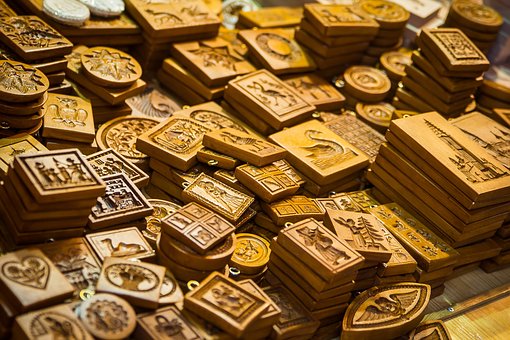The Christmas season wouldn’t be complete without Christmas cookies. One such Christmas cookie is the speculaas cookie traditionally made and eaten on or before December 6, St. Nicholas’ Day. These cookies are made by pressing molds carved with seasonal symbols in the batter and then baked. The word “speculaas” is from the latin speculum which means mirror referring to the “mirrored” images that the molds make in the cookies.
The spices used in the cookies, cinnamon, nutmeg, cloves, cardamom, ginger and white pepper, are characteristic of the 15th and 16th centuries thanks to the spice trade carried on by the Dutch East India Company. You can grow some of these spices yourself. The rest you can purchase and grind.
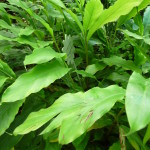
Cardamom
Cardamom – (Elettaria cardamomum) is a tropical plant grown from a rhizome but it is the seeds that are used as a spice. If you live north of the tropics, you can grow cardamom plants in deep containers. Keep them indoors during cold winter. Because they require high humidity, you should mist your plants regularly while they are indoors. Our houses are very dry. You can move your containers outdoors in the late spring when night time temperatures are consistently above 40⁰F. Move them indoors in the fall when night time temperatures fall below 40⁰F. Dry the pods on screens for 6 or 7 days, turning them frequently. Once the pods are dry, the seeds are ready to be harvested. Because the seeds lose their freshness and flavor very quickly, they should be stored in their dried pods until they are used.
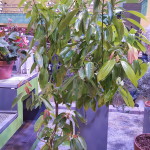 Cinnamon – (Cinnamomum verum) is made from the bark of the cinnamon tree. It is a tropical tree, native to southwest India, Madagascar and Sri Lanka and only hardy in zones 10 through 12. The rest of us have to grow it in containers and bring it indoors during the winter. In smaller pots, it should be kept pruned to 3 feet but if you have room for a larger container, you can prune to 8 feet. Cinnamon prefers full sun and dry soil. To harvest, score the bark and then peel it from the tree. It will naturally roll up. Cut the rolls into 3 inch lengths for easy handling. Dry them as you would any other herb. Alternatively, you can purchase cinnamon “sticks” at any grocery store.
Cinnamon – (Cinnamomum verum) is made from the bark of the cinnamon tree. It is a tropical tree, native to southwest India, Madagascar and Sri Lanka and only hardy in zones 10 through 12. The rest of us have to grow it in containers and bring it indoors during the winter. In smaller pots, it should be kept pruned to 3 feet but if you have room for a larger container, you can prune to 8 feet. Cinnamon prefers full sun and dry soil. To harvest, score the bark and then peel it from the tree. It will naturally roll up. Cut the rolls into 3 inch lengths for easy handling. Dry them as you would any other herb. Alternatively, you can purchase cinnamon “sticks” at any grocery store.
 Ginger – (Zingiber officinale) is another ingredient in your pumpkin spice mix that you can grow yourself. In this case, it is the root that you will be using. Ginger is native to south China and hardy in zones 9 through 12. If you live north of zone 9, you can grow it in a container. Ginger has a long growing season, 10 months to maturity, so you will need to start it indoors, put it outside during the summer and then bring it back in in the fall. The root is ready to be harvested when the foliage starts to die back in the fall. You can dry the root yourself or buy ginger root to dry at home in the produce section of your grocery store.
Ginger – (Zingiber officinale) is another ingredient in your pumpkin spice mix that you can grow yourself. In this case, it is the root that you will be using. Ginger is native to south China and hardy in zones 9 through 12. If you live north of zone 9, you can grow it in a container. Ginger has a long growing season, 10 months to maturity, so you will need to start it indoors, put it outside during the summer and then bring it back in in the fall. The root is ready to be harvested when the foliage starts to die back in the fall. You can dry the root yourself or buy ginger root to dry at home in the produce section of your grocery store.
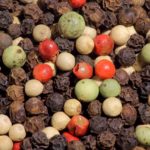 Peppercorns – (Piper nigrum) is the fruit of a tropical vine which can reach 12 feet in length so it’s important that you provide it with some kind of support to climb on. The vines are woody perennials that are hardy in zones 10 and 11. They require both heat and humidity so it is important that you not let your plants dry out. Temperature is also critical. The vines will die below 60⁰F. Even the soil they grow in must be warm, ideally between 75⁰F and 85⁰F. If you live and garden north of zone 10 and grow your vine in a container, keep your container indoors until early summer and be sure to bring it back indoors in the early fall before the nights become too cool. For white peppercorns, the fruit is harvested when it is red and fully ripe. The fruit is soaked until the flesh is soft enough to remove. The inner seed, which is white, is then dried. It retains its white color after drying.
Peppercorns – (Piper nigrum) is the fruit of a tropical vine which can reach 12 feet in length so it’s important that you provide it with some kind of support to climb on. The vines are woody perennials that are hardy in zones 10 and 11. They require both heat and humidity so it is important that you not let your plants dry out. Temperature is also critical. The vines will die below 60⁰F. Even the soil they grow in must be warm, ideally between 75⁰F and 85⁰F. If you live and garden north of zone 10 and grow your vine in a container, keep your container indoors until early summer and be sure to bring it back indoors in the early fall before the nights become too cool. For white peppercorns, the fruit is harvested when it is red and fully ripe. The fruit is soaked until the flesh is soft enough to remove. The inner seed, which is white, is then dried. It retains its white color after drying.
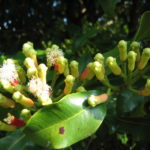 Cloves – (Syzygium aromaticum) are the unopened flower buds of the clove tree which is native to Indonesia. It is hardy in zones 10 and 11. Clove trees are very difficult to grow because they require tropical temperatures, high humidity and lots and lots of water (5 to 8 inches per month). They are not suitable for growing in containers. The buds are harvested when they start to turn red and then dried for use. Whole dried cloves are available in any grocery store.
Cloves – (Syzygium aromaticum) are the unopened flower buds of the clove tree which is native to Indonesia. It is hardy in zones 10 and 11. Clove trees are very difficult to grow because they require tropical temperatures, high humidity and lots and lots of water (5 to 8 inches per month). They are not suitable for growing in containers. The buds are harvested when they start to turn red and then dried for use. Whole dried cloves are available in any grocery store.
 Nutmeg – (Myristica fragrans) is made from the seeds of the nutmeg tree. The seed covering, or aril, is the spice mace. Nutmeg is native to Indonesia and hardy in zones 10 and 11. It is not suitable to be grown in containers for several reasons. It is a multi-stemmed evergreen tree that grows to 40 to 60 feet tall with roots that reach 4 feet down. It doesn’t start producing seeds until maturity, about 7 to 9 years. Whole, dried nutmeg seeds can be purchased at your local grocery store.
Nutmeg – (Myristica fragrans) is made from the seeds of the nutmeg tree. The seed covering, or aril, is the spice mace. Nutmeg is native to Indonesia and hardy in zones 10 and 11. It is not suitable to be grown in containers for several reasons. It is a multi-stemmed evergreen tree that grows to 40 to 60 feet tall with roots that reach 4 feet down. It doesn’t start producing seeds until maturity, about 7 to 9 years. Whole, dried nutmeg seeds can be purchased at your local grocery store.
Speculaas spice is made up of ground spices. Spices can be ground in three ways. You can use a traditional mortar and pestle. This is good for small amounts of dried spices. A microplane is also a good tool for grinding small quantities of spices. Both of these require some muscle. If you lack time or strength, you can use a spice grinder or coffee grinder. Both of these are also useful if you need to grind large amounts of spices. A word of caution – if you use your coffee grinder to grind your spices, be sure to wash it really well or your coffee will taste funny.
To make your speculaas spice, blend your ground spices as follows:
2 ½ tablespoons cinnamon
2 teaspoons nutmeg
2 teaspoons ground cloves
1 teaspoon white pepper
1 teaspoon ground ginger
1 teaspoon cardamom
Leftover speculaas spice should be stored in an air tight container in a cool, dark, dry place.

